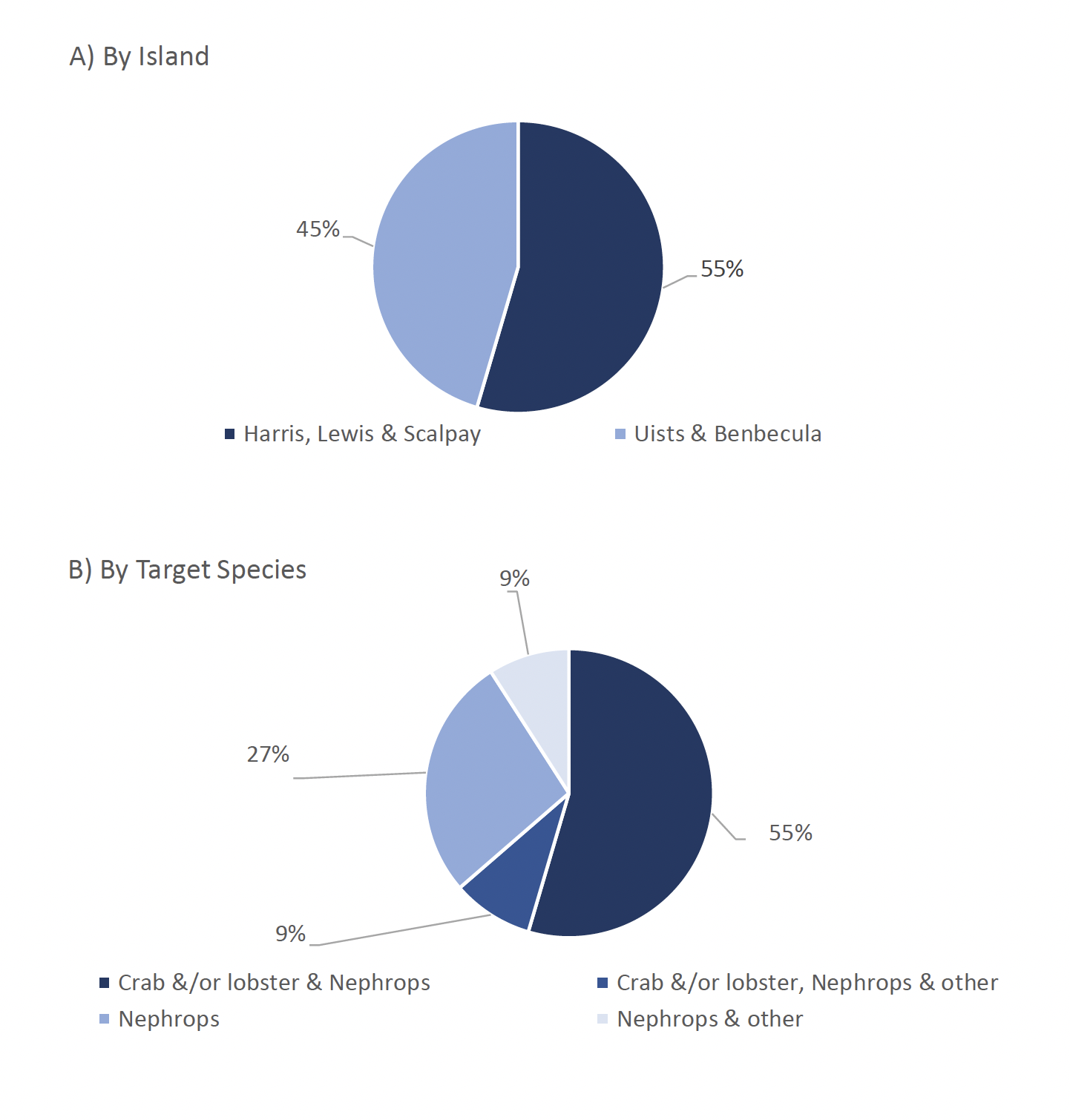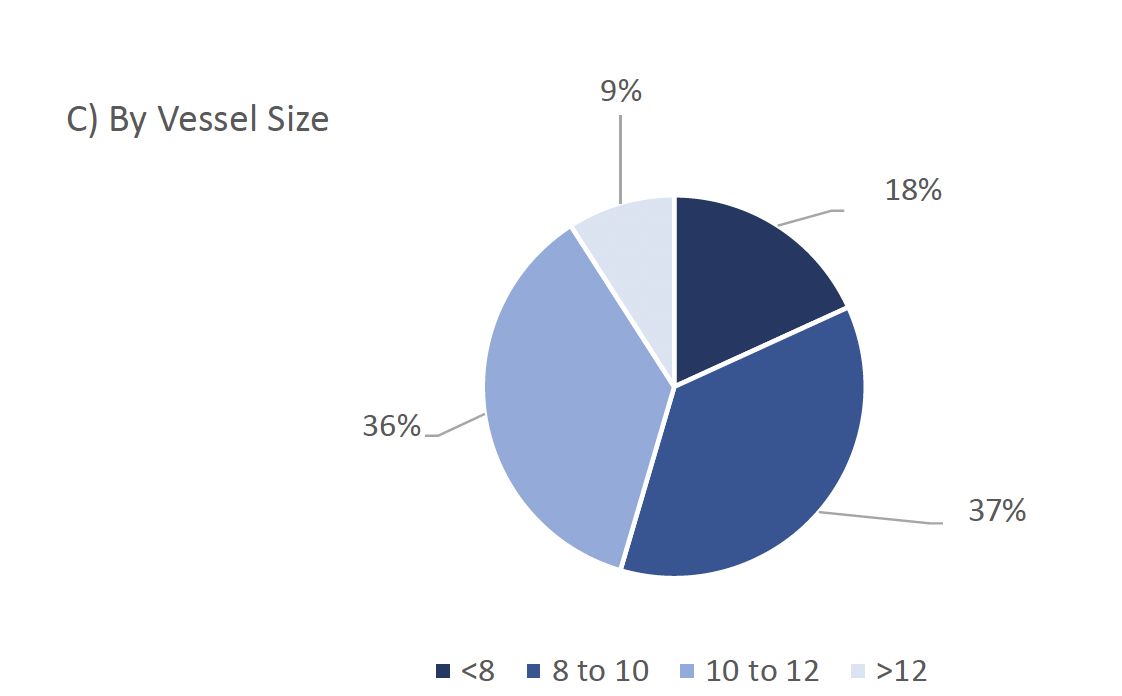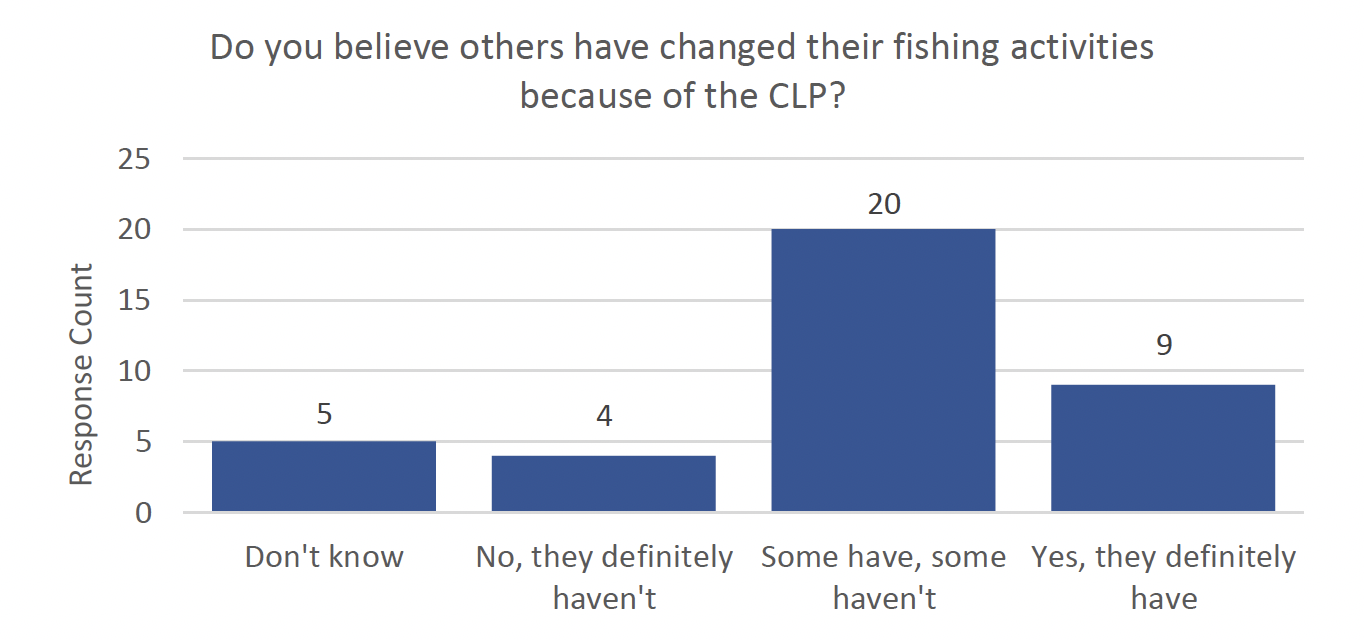Outer Hebrides creel limitation pilot: research and evaluation
Presents the findings of the survey made into the operational implications and socio-economic impacts of the Outer Hebrides Creel Limitation Pilot on fishers.
Operational Implications
Key findings
- 23% of fishers made changes to their fishing activities as a result of the CLP.
- The most common change was in reducing creel numbers, though there were no clear drivers in terms of location, fishery type or vessel size, for doing this.
- 54% of interviewees said that the creel limits were too high and wanted to see them lowered.
- 65% of survey respondents believed that there had been no changes in policing despite the derogation being a legal requirement.
Survey and interview participants were asked about how the CLP had impacted their fishing operations. Specific operations that fishers were asked about included fishing location, distance travelled, number of creels, soak times, trip times and number of fishing days per week.
Of the survey respondents (n=39), nine (23%) reported making changes to their fishing activities. Of these nine respondents, all were participants in the CLP. Of the interview respondents, six fishers (23%) (n=26), have changed their fishing activities. Of those six interviewees, all were also CLP participants. The respondents that had made changes to aspects of their fishing activities were asked further questions about the nature of those changes. None of these respondents had made changes to their fishing locations or the number of days fished per week. Drivers for change were investigated only for those that reduced their creel numbers on account of small sample sizes (n<=5) for other changes.
The main changes that were made were as follows:
Distance
Of the survey respondents that have changed their fishing activities (n=9), one (11%) has changed their distance travelled per fishing trip, reducing the distance by 1-10 km.
Additionally, one interview respondent reported a reduction in distance travelled. Another interviewee hypothesised that the decision to reduce the distance travelled may instead be a result of an increase in the cost of fuel.
Time at sea
Of the survey respondents that have changed their fishing activities (n=9), a third have decreased the amount of time spent at sea by 0-2 hours.
An additional two interviewees have also reduced the amount of time they spend at sea because they are hauling less gear.
Creel numbers
Of the survey respondents that have changed their fishing activities (n=9), 56% have decreased their fleets by more than 50 creels.
Of those interviewed, six additional respondents have reduced their creel numbers, though one did so out of preference and not as a direct result of the CLP. As this was the most popular change to operational patterns, the drivers for change, including vessel size (relating to the creel limits), target species, and a fisher's location, were explored (Figure 3). Of note, no fishers residing in Barra or Vatersay made any changes to their creel numbers. The majority of fishers that had reduced their creel numbers fish for a combination of crab and/or lobster with Nephrops from mid-sized vessels between 8 and 12m in length.


Soak time
Of the survey respondents that have changed their fishing activities (n=9), one fisher (11%) has reduced their soak time by more than one week.
An additional three interviewees also made changes to their soak times because of the CLP. Each adapted their soak times differently; with fewer creels, the first fisher can now haul all their creels every day, thereby reducing their soak time. Because of the CLP, the second fisher is now able to get by working a three-day week and hauling their creels every other day, though they did not mention what their soak time was before the CLP. Their adaptation of soak time, unlike the first fisher, is because the economics have improved. Similarly, the third fisher lifts all their creels on a two-day cycle, lifting four-hundred one day and the remaining two-hundred and forty the second day. Before the CLP, the third fisher would haul all their creels every day to make their business economically viable. In marginally increasing their soak times, they have reduced their effort for the same or better returns.
Expected landings
Of the survey respondents that have changed their fishing activities (n=9), seven (78%) expect their landings to increase and two (22%) expect that their landings will stay the same. For more information on what fishers have noticed about shellfish stocks and landings because of the CLP, see 'Economic Implications: Shellfish stocks and Landings'.
Policing
Of the survey respondents that were participating in the CLP (n=34), six (18%) believe that policing has increased, twenty-two (65%) believed that it had remained the same and six (18%) were unsure.
Other's fishing activities
To determine what fishers thought towards the operational patterns of their contemporaries, fishers were asked if others had made changes to their fishing operations. Of the survey respondents (n=39), the majority assume that there has been a mixed response to the CLP, reckoning that some had changed their operating patterns and some had not (Figure 4). Of the survey respondents, twenty (53%) (n=38) believe that some fishers have changed their operations and some have not. A further nine (24%) believe that other fishers had made changes to their fishing operations. How respondents think others have adapted their operational patterns is documented in Table 5. (Two respondents answered this question in both the survey and the interviews where their answers were contradictory and so their answers have not been included in Table 5.)

| Code | Code Description | Number of Respondents |
|---|---|---|
| Reduced creels | Respondents reported that they noticed some other fishers reducing their creel numbers. | 15 |
| Increased creels | Respondents reported that they had noticed some other fishers increasing their creel numbers or effort, possibly to get up to the limit. | 6 |
| Displacement | Respondents reckoned that some fishers were displacing some or all of their effort outside the pilot area so that they can fish the same number of creels without breaking the regulations. | 4 |
| Reduced soak times | Respondents alluded to others lifting their creels more frequently and not leaving gear soaking indefinitely. | 4 |
| Rule breaking | Respondents reported that some fishers are deliberately not sticking to the regulations laid out in the CLP. | 3 |
| Less vessels | Respondents believe that some other fishers (with large vessels and many creels higher than the limit) came out of the fishery before the creel limits were enforced or moved out of their area more frequently to target other species. | 3 |
| More space | Respondents stated that there was now more space on the grounds than previously but did not mention an individual gear reduction as the reason. | 3 |
| Additional vessels | Respondents believe that some other fishers have bought an additional vessel to work their grounds or seen an uptake of new smaller vessels to gather the benefits of the CLP. | 2 |
| Creel management | Respondents reported that some other fishers that fish different target species with different types of creel have had to remove some creels to put out a different type of creel for a different target species. | 2 |
| Less time at sea | Respondents reckon that some other fishers are spending less time at sea. | 1 |
| Prevent new entrants | Respondents suggested that the CLP regulations have prevented some new entrants to the fishery, particularly those that would have joined with several thousand pots. | 1 |
| Staying east | Respondent reckons some vessels that would usually switch from fishing in the east to fishing on the west of the Hebrides are instead staying on the east, inside the pilot area. This could be due to better returns in the east or the increased cost of fuel making it less economical to travel further. | 1 |
| Increased soak times | Respondent suggested that soak times were longer as some others were fishing more creels and not hauling them all every day. | 1 |
Of the twenty-six fishers interviewed, fourteen (54%) said that the creel limits were not conservative enough, desiring to see them come down further. Many argued that the limits were so high that it did not make a difference to the number of creels in the water. There were seven respondents (27%) that felt that the limits were appropriate and one (4%) thought that the limits were too conservative, wanting to manage the number of creels without limiting them. One respondent (4%) was unsure. A respondent (4%) wanted the limits to be slightly higher for smaller vessels to allow fishers to fish different types of creels without having to take some ashore, and a lower limit for larger vessels.
Five respondents (19%) stated that they would like to see a limit of one-thousand creels regardless of vessel size and one respondent also commented on the number of crew, stating that a vessel would need one-thousand creels if it is financially supporting three or more crew members. The opinion on the creel limit was not related to the size of the vessel (Fisher's Exact Test: p=0.95 | n=21). (Respondents were asked whether they thought the creel limits were too conservative, not conservative enough or just right. When cross-referenced for those respondents that answered both the survey and interview, it was noticed that their answers were contradictory. It is assumed that this is because the question wording was unclear or misinterpreted, therefore only the interview responses where a researcher could expand on the question and check the results were analysed.)
Contact
Email: inshore@gov.scot
There is a problem
Thanks for your feedback